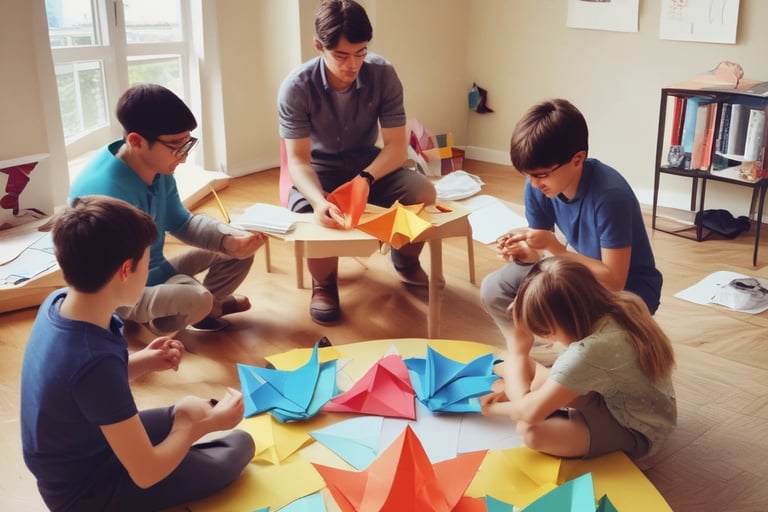Creating Significant Learning Enviroments- EDLD 5313
Transforming Teaching: Creating Significant Hybrid Learning Environments
In today’s dynamic educational landscape, the teacher’s role has evolved from content deliverer to designer of authentic, inclusive, and meaningful learning experiences. This blog and the work it showcases go beyond collecting academic assignments; they reflect a deep commitment to teaching that transforms, humanizes, and inspires. As a second-grade teacher and teacher educator, I’ve come to understand that hybrid learning is not merely a format; it’s a powerful pedagogical strategy to enhance literacy, foster engagement, and support students ethically and inclusively.
This space is grounded in the vision of Creating Significant Learning Environments (CSLE) (Harapnuik, 2021), which calls for the intentional design of learning spaces where students feel safe, engaged, and empowered to grow. Designing significant hybrid learning environments means creating experiences that are emotionally meaningful, culturally relevant, and deeply connected to students' lives. Rooted in frameworks such as Meaningful Learning (Ausubel, 1963), Backward Design (Wiggins & McTighe, 2005), and Universal Design for Learning (Nelson et al., 2021), this blog offers ideas, resources, and reflections to empower teachers to implement real change. Here, technology becomes more than a tool it becomes a vehicle for connection, inclusion, and creativity (Bates, 2014; Thomas & Brown, 2011).
This journey is guided by an educational philosophy grounded in five principles: Connecting with students, Exploring with curiosity, Constructing with purpose, Integrating with awareness, and Innovating with intention (CECII). This approach bridges theory and practice, providing a straightforward yet powerful framework for transforming classroom experiences. This portfolio is an invitation to reimagine education with passion, empathy, and purpose, recognizing that every child deserves to learn in a space where they feel seen, valued, and heard. It also acknowledges that every teacher can lead this transformation from within their own classroom.




The course EDLD 5313 Creating Significant Learning Environments has been essential in transforming my educational philosophy. Beyond delivering content, it taught me that authentic learning happens when we design meaningful environments that connect with students’ identity, curiosity, and lived experience. By integrating theories such as Significant Learning (Fink, 2003), Universal Design for Learning (Nelson et al., 2021), and the New Culture of Learning (Thomas & Seely Brown, 2011), this course has inspired me to build spaces that nurture not only knowledge, but also passion, autonomy, and the ability to learn how to learn. It is a cornerstone for creating an innovative, ethical, and profoundly human teaching practice.
Beyond Content: Creating Inspiring Learning Environments
A New Culture of Learning
This work comes from a core belief: students don’t need more control; they need more inspiration. Inspired by A New Culture of Learning, I propose environments where play, passion, and community guide learning.
My approach aligns with my hybrid classroom innovation plan, aiming for fundamental transformation: learning with purpose and growing with freedom.

Grounded in Context: Designing with Purpose in a Changing Educational Landscape
This first worksheet is essential because it lays the foundation for instructional design through a deep understanding of the learning context. By identifying student characteristics, institutional conditions, available resources, and potential barriers or opportunities, this exercise ensures that the course is not a generic proposal but rather a learning experience aligned with real-life situations. Instead of starting from assumptions, it begins with people and their environments. This type of analysis fosters more empathetic, flexible, and inclusive pedagogical decisions, allowing the methodological process to respond to the participants’ needs honestly. In this way, an authentic design journey begins, where each course component gains meaning and purpose to its context (Wiggins & McTighe, 2005).


Worksheet 1: Learning Environment-Situational Factors document

Desired Results: A Purposeful Start for Meaningful Learning
This second worksheet focuses on identifying the desired learning results that will guide the entire course design. Drawing from the principles of Backward Design (Wiggins & McTighe, 2005), this stage invites us to begin with the end in mind: to define what truly matters in terms of enduring understandings, essential questions, and transferable knowledge and skills. Rather than listing content, this step emphasizes deeper learning outcomes that encourage teachers to reflect, question, and act with intention. These desired results serve as a compass for all learning experiences, ensuring coherence between goals, instructional activities, and assessment strategies. This process is further enriched by the ISTE Standards for Educators (ISTE, 2017), which promote the integration of technology, equity, inclusion, and student empowerment at the heart of the learning process.
By grounding the design in clear, relevant, and significant goals aligned with standards, pedagogical theory, and contextual realities, we lay the foundation for learning that is not only measurable but truly transformative. This reflection aligns with the call to Create Significant Learning Environments (Fink, 2003) and cultivate a New Culture of Learning (Thomas & Seely Brown, 2011), where educators lead change and learning grows through purpose, passion, and authenticity.


Worksheet 2: Questions for Formulating Significant Learning Goals
This section is just the beginning. As we move forward, we will delve deeper into the enduring understandings, essential questions, and key knowledge that bring the course design to life. I invite you to keep exploring how these desired results translate into authentic learning experiences aligned with the purpose of teaching with meaning and transforming from within the classroom.

Designing with Purpose: Aligning Goals, Evidence, and Learning
The Three-Column Table is a foundational tool within the Understanding by Design (UbD) framework, as it makes visible the alignment between desired results, acceptable evidence, and planned learning experiences. This structure helps ensure that teaching is purposeful, assessments are authentic, and learning activities are fully aligned with what truly matters (Wiggins & McTighe, 2005).
More than a planning chart, this tool reflects a deep commitment to learner-centered design and the creation of significant learning environments (Fink, 2003). By focusing on enduring understandings and transferable skills, the table supports the design of experiences that go beyond academic content and connect to real-world, inclusive, and hybrid teaching contexts. The second column, which defines acceptable evidence, reinforces the importance of designing assessments that allow learners to demonstrate understanding in meaningful and creative ways (McTighe & Seif, 2011).
Integrating goals, evidence, and learning experiences into a single, cohesive view transforms instructional planning into a strategic and intentional act. This table serves as a bridge between vision and practice, making learning visible, measurable, and deeply relevant to both teachers and students.


Learning Outcomes 3 Column Table
This section opens the door to a deeper understanding of intentional instructional design. I invite you to explore how the desired results, authentic evidence, and learning experiences of each column intertwine to bring a coherent, meaningful, and student-centered course to life. Each element was designed not just to teach but to transform.

This section presents the development of my course using the Understanding by Design (UbD) framework. Through its three stages: Desired Results, Assessment Evidence, and Learning Plan. I structured a learning experience that is purposeful, standards-aligned, and centered on student growth.
Development of the UbD Design Template

Designing with Purpose: A Comparative Reflection on Fink and UbD
Designing a course is not just about organizing content; it's about envisioning possible futures, creating transformative experiences, and sowing the seeds of lasting learning. During the development of this instructional proposal, I integrated two widely recognized methodological frameworks known for their capacity to create significant learning environments: the UbD Design Template by Wiggins and McTighe, and Fink’s Three Column Table. Each framework spoke to me from a different perspective, yet both offered tools, clarity, and valuable guidance for structuring a course aligned with my pedagogical purpose: a space to prepare teachers to embrace hybrid learning as an inclusive strategy to strengthen students' reading, writing, and engagement.
Fink: Designing with Heart, Mind, and Purpose
UbD: Designing with Clarity, Evidence, and Shared Vision
Fink’s model (2003) was my starting point because it encouraged me to view learning through a human, emotional, intellectual, and practical lens. Unlike other technical models, Fink did not ask me to begin with content, but rather with what I truly want my teachers to feel, understand, and transform. How do they connect with their purpose? What skills do they need to initiate change? What do they need to learn to teach with inclusion and passion?
Organizing the course using Fink’s six dimensions of significant learning, foundational knowledge, application, integration, human dimension, caring, and learning how to learn allowed me to build a bridge between the being of a teacher and the doing of teaching. It helped me include moments for identity reflection, real-world applications, empathy-building exercises, and tools that promote autonomy and lifelong learning. In Fink, I found a compass for designing with meaning, not just with structure. It reminded me that truly significant learning begins with an emotional connection and a sense of purpose.
Once the core pedagogical vision was defined through Fink, I needed to bring it to life with clarity and action. This is where the Understanding by Design (UbD) model, developed by Wiggins and McTighe (2005), provided a structured and strategically powerful framework. UbD begins with a transformative question: What do we want students to understand and be able to do by the end of the learning experience?
Designing from the desired results, rather than starting with activities, required a mindset shift and a deeper level of planning. UbD helped me formulate enduring understandings, those big ideas worth holding onto; develop essential questions that spark curiosity and reflection; and create authentic performance tasks that challenge participants to demonstrate their learning in real-life contexts. I was able to intentionally align goals, assessments, and activities while ensuring the course met TEKS, ISTE standards, and the practical needs of hybrid classrooms. UbD taught me that structure does not limit creativity it empowers it.




Fink and UbD Together: A Complete Compass to Transform Teaching
Integrating both models revealed that instructional design is not about choosing one path over another, but about understanding how diverse approaches can complement and enrich each other. Fink helped me look inward, embracing the human, emotional, and reflective dimensions of learning. UbD helped me look forward, grounding my design in clarity, intentionality, and measurable outcomes. Fink offered the language of purpose, inviting me to ask: What kind of teacher do we hope to develop? UbD provided the language of evidence, guiding me to answer: What must they learn, do, and demonstrate to grow into that role? Designing this course has been a transformative experience. It has allowed me to solidify my identity as an educational leader capable of aligning vision, strategy, technology, and inclusion. I now feel equipped and empowered to help others design learning environments where students and educators not only succeed but truly flourish. As Harapnuik (2021) reminds us, designing significant learning environments requires more than content delivery it demands trust, autonomy, authenticity, and a deep connection to purpose. This is the kind of design that shapes cultures of learning, not just lessons.
This journey of instructional design has been more than an academic exercise—it has been a return to the heart of teaching: to design with meaning, to teach with purpose, and to lead with empathy. Throughout the process, I have been guided by powerful frameworks such as Backward Design (Wiggins & McTighe, 2005), Significant Learning (Fink, 2003), and the ISTE Standards for Educators (2017), alongside voices that remind us that learning is a living process—one that involves imagination, curiosity, community, and care (Thomas & Brown, 2011; Harapnuik, 2021).
This work has also been deeply enriched by the wisdom of other scholars:
Thomas and Brown (2011) reminded me that learning flourishes when it is nurtured by passion, play, and community.
Bates (2014) challenged me to select technology with intention and pedagogical value, not as an add-on.
Nelson et al. (2021) emphasized the importance of designing for diverse learners, ensuring access, equity, and opportunity through Universal Design for Learning (UDL).
Designing with intention has become, for me, a way to reconnect with the deeper purpose of education. Every phase—from analyzing the context to envisioning a bold goal, and aligning outcomes, evidence, and experiences—was a bridge between pedagogy and life, between structure and transformation. In the end, aligning outcomes, assessment, and activities is not just a technical task—it is an act of ethical and human-centered design. Each tool, each model, and each reflection has helped me weave vision with structure, and empathy with strategy. What I carry forward is the certainty that when we design from a place of authenticity, inclusion, and openness to change, learning becomes not only meaningful but also alive.

REFERENCES
Bates, T. (2014). Teaching in a digital age: Guidelines for designing teaching and learning. Tony Bates Associates Ltd. http://www.tonybates.ca/2014/07/29/teorias-del-aprendizaje-y-aprendizaje-en-linea/
Fink, L. D. (2003). Creating significant learning experiences: An integrated approach to designing college courses. Jossey-Bass.
Harapnuik, D. (2021). CSLE + COVA: Creating Significant Learning Environments to give learners Choice, Ownership, and Voice through Authentic learning opportunities. Retrieved from https://www.harapnuik.org/?page_id=7547
International Society for Technology in Education. (2017). ISTE Standards for Educators. https://www.iste.org/standards/iste-standards-for-teachers
McTighe, J., & Seif, E. (2011). An implementation framework to support 21st century skills. In J. Bellanca & R. Brandt (Eds.), 21st Century Skills: Rethinking How Students Learn (pp. 155–176). Solution Tree Press.
Nelson, L. L., Kennedy, M., & Tippett, C. D. (2021). Design and deliver: Planning and teaching using universal design for learning. Brookes Publishing.
Thomas, D., & Seely Brown, J. (2011). A new culture of learning: Cultivating the imagination for a world of constant change. CreateSpace.
Wiggins, G., & McTighe, J. (2005). Understanding by design (Expanded 2nd ed.). ASCD.
